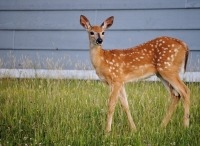
(Photo: Johanne Dugas)
White-Tailed Deer
Odocoileus virginianus
In summer the white-tailed deer is tan or brown but in winter its coat is greyish brown. It has, as its name suggests, a white underside to its tail. It also has white on its throat, around its eyes, and on its stomach. Males have antlers and shed them between January and March before regrowing them. Males can weigh up to 136 kilograms and females up to 91 kilograms. Body length can be up to 200 centimetres.
Authority
Zimmermann, 1780
Classification Details
Phylum: Chordata (chordates); Subphylum: Vertebrata (vertebrates); Class: Mammalia (mammals); Family Cervidae - cervids, caribou, deer, moose and wapiti.
Habitat
Native to North America and South America as far south as Bolivia. Found in most of southern Canada. Can survive in a variety of habitats from Canadian forests to Florida swamps. Typically found in wooded areas. A deer's home range is usually less than a square mile (2.5 squared kilometres). Deer live in family groups of a mother and her fawns. Bucks may live in groups with other males. Does without fawns and bucks in the breeding season are usually solitary.
Diet
Herbivores. The type of vegetation eaten depends on what is in their habitat and the season. Diet may include coniferous and deciduous trees, shrubs, plants, acorns and nuts and even seaweed. Whitetail deer are crepuscular: feeding around dawn and dusk.
Reproduction
Sexes are separate. Does (female deer) are fertile for a 24-hour period in November. If she is not mated a second fertile period occurs 28 days later. Bucks may mate with several females. Gestation is around six and a half months. Does usually have one or two fawns per litter. At birth, fawns weigh 1.5-2.5 kilograms and can already walk. A doe will leave her fawn for up to four hours to forage. The fawns are camouflaged against the forest floor. From four weeks the fawn will go foraging with its mother. Mothers nurse their fawns for up to 10 weeks, Fawns stay with their mother for one to two years. Most deer live for two to three years but can occasionally live for 20 years.
Fun Facts
Deer are strong swimmers. The lighthouse keeper on Machias Island in the Gulf of Maine was surprised to spot one there in 2014: the nearest land is 16 kilometres away. Biologists think it swam there from the United States.
Young fawns are left while their mothers forage. They are well camouflaged but to stop predators finding them by scent, the mother will eat its fawn's faeces. The fawn waits to “go” until its mother returns.
References
Applegate RD and Gray PB (1995) Nutritional value of seaweed to ruminants. Rangifer 15, 15–18. CBC. https://www.cbc.ca/news/canada/new-brunswick/deer-swims-from-u-s-to-gulf-of-maine-s-machias-seal-island-1.2837813 Accessed online 25 August 2020. Dewey, T. 2003. "Odocoileus virginianus" (On-line), Animal Diversity Web. https://animaldiversity.org/accounts/Odocoileus_virginianus/ Accessed August 25, 2020 New Hampshire PBS. 2020. Nature Works: the white-tailed deer. https://nhpbs.org/natureworks/whitetaileddeer.htm Accessed August 25, 2020.

